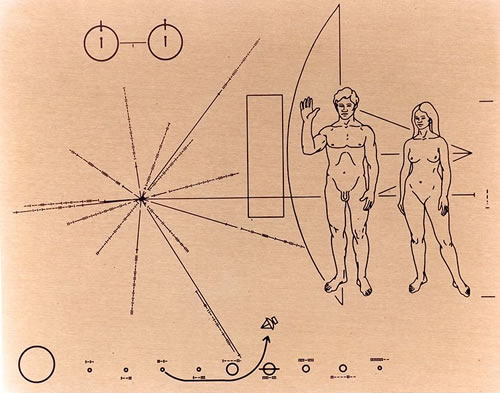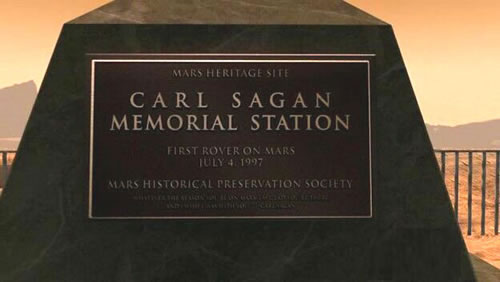Neatorama presents 10 Neat Facts About Carl Sagan:
1. Carl Sagan's First Book About Stars
When Carl was five years old, he wondered about the stars: what were they? Unsatisfied with the answers he got from his friends and from adults he knew, Carl went to the library and asked for a book about stars. The librarian handed him ... a book on celebrities! In Keay Davidson's Carl Sagan: A Life, Carl explained how his fascination with the cosmos began:I gave it back to her and said, "This wasn't the kind of stars I had in mind." She thought this was hilarious, which humiliated me further. She then went and got the right kind of book. I took it—a simple kid's book. I sat down on a little chair—a pint-sized chair—and turned the pages until I came to the answer.
And the answer was stunning. It was that the Sun was a star but really close. The stars were suns, but so far away they were just little points of light.... And while I didn't know the [inverse] square law of light propagation or anything like that, still, it was clear to me that you would have to move that Sun enormously far away, further away than Brooklyn [for the stars to appears as dots of light]....
The scale of the universe suddenly opened up to me. [It was] kind of a religious experience. [There] was a magnificence to it, a grandeur, a scale which has never left me. Never ever left me.
2. Sagan vs. Apple
In 1994, Apple chose the internal codename "Carl Sagan" for its PowerMac 7100. Though it was meant as an homage to Carl (and an in-joke that the computer would make Apple "billions and billions" of dollars), they also used the codenames "Piltdown Man" and "Cold Fusion" for the Power Mac 6100 and 8100, respectively. When Carl found out that he was being put alongside scientific hoaxes, he sued Apple. Though Apple won the suit, the codename was changed to BHA (Butt Head Astronomer) ... which prompted yet another lawsuit from the p.o.'d astronomer! Apple won again, but their lawyers demanded the engineers change the codename one more time, which they did. The PowerMac 7100 was known by its final codename LAW, which stood for "Lawyers Are Wimps."3. Spaced Out ... On Pot!
In 1969, Carl Sagan wrote under the Pseudonym "Mr. X" about the virtues of cannabis. Harvard Medical School Professor Emeritus of Psychiatry Lester Grinspoon has the article in his website Marijuana Uses:It all began about ten years ago. I had reached a considerably more relaxed period in my life - a time when I had come to feel that there was more to living than science, a time of awakening of my social consciousness and amiability, a time when I was open to new experiences. I had become friendly with a group of people who occasionally smoked cannabis, irregularly, but with evident pleasure. Initially I was unwilling to partake, but the apparent euphoria that cannabis produced and the fact that there was no physiological addiction to the plant eventually persuaded me to try. My initial experiences were entirely disappointing; there was no effect at all, and I began to entertain a variety of hypotheses about cannabis being a placebo which worked by expectation and hyperventilation rather than by chemistry. After about five or six unsuccessful attempts, however, it happened. I was lying on my back in a friend's living room idly examining the pattern of shadows on the ceiling cast by a potted plant (not cannabis!). I suddenly realized that I was examining an intricately detailed miniature Volkswagen, distinctly outlined by the shadows. I was very skeptical at this perception, and tried to find inconsistencies between Volkswagens and what I viewed on the ceiling. But it was all there, down to hubcaps, license plate, chrome, and even the small handle used for opening the trunk. When I closed my eyes, I was stunned to find that there was a movie going on the inside of my eyelids. Flash . . . a simple country scene with red farmhouse, a blue sky, white clouds, yellow path meandering over green hills to the horizon. . . Flash . . .
4. The Politics of Science
Anyone who has ever worked in a university or an academic institution would know this, but most people assume that because science relies on logic and careful reasoning, scientists would behave in a clinical and dispassionate way. Nothing is farther from the truth.Carl's popularity had backfired on him not once but twice. In 1967, he was denied tenure at Harvard because his colleagues bristled at "what they perceived as self-aggrandizement and pandering to the public."
In 1992, Carl was again disappointed when his application for membership at the prestigious National Academy of Sciences was denied. Ironically, he received the Public Welfare Medal, the highest award of the Academy for "distinguished contributions in the application of science to the public welfare."
In both instances, Carl persevered and succeeded to overcome setbacks resulting from the politics of science.
5. Billions and Billions
Carl Sagan actually never used the term "billions and billions." His exact words on the series Cosmos were "billions upon billions" (which, for all practical purpose, is pretty much the same thing).6. The Sagan Unit
A sagan is defined as at least 4 billion (the smallest amount in "billions" is two billion, so "billions and billions" equal 4 billion). It is estimated that the Milky Way galaxy has 100 sagan (400,000,000,000) stars.Previously on Neatorama: Fun and Unusual Units of Measurements
7. Pioneer Plaques

Many people know that Pioneer 10 and Pioneer 11 spacecrafts carry metal plaques that carry a message from mankind. But not many know that it was Carl Sagan, together with Frank Drake (yes, the man who came up with the Drake Equation that attempts to estimate the number of alien civilization in our galaxy), that designed the plaque. The controversial artwork, which featured a nude man and woman, was drawn by Sagan's then-wife Linda Salzman Sagan.
After the Pioneer Program, NASA put a Golden Record aboard the two Voyager spacecrafts, which included a greeting "Hello from the children of planet Earth." That was recorded by then six-year-old Nick Sagan, Carl's son.
8. Carl Sagan Memorial Station ... on Mars!
Nick Sagan grew up to become a novelist and screenwriter. He wrote an episode of Star Trek: Enterprise titled "Terra Prime," which included a CGI of Carl Sagan Memorial Station plaque on Mars.


No hay comentarios:
Publicar un comentario